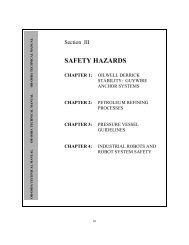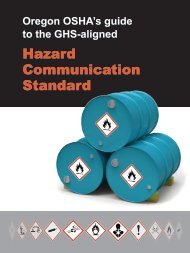Asbestos - Rules of Abatement - Oregon OSHA
Asbestos - Rules of Abatement - Oregon OSHA
Asbestos - Rules of Abatement - Oregon OSHA
Create successful ePaper yourself
Turn your PDF publications into a flip-book with our unique Google optimized e-Paper software.
Background<br />
<strong>Asbestos</strong> is the generic term for a group <strong>of</strong> naturally occurring fibrous minerals<br />
with high tensile strength, flexibility, and resistance to thermal, chemical, and<br />
electrical conditions.<br />
Exposure to asbestos can cause disabling or fatal diseases such as asbestosis, an<br />
emphysema-like condition; lung cancer; mesothelioma, a cancerous tumor that<br />
spreads rapidly in the cells <strong>of</strong> membranes covering the lungs and other organs;<br />
and gastrointestinal cancer. The symptoms <strong>of</strong> these diseases generally do not<br />
appear for 20 years or more after exposure.<br />
<strong>Asbestos</strong> fibers enter the body by inhalation or ingestion <strong>of</strong> airborne particles<br />
that become embedded in the tissues <strong>of</strong> the respiratory or digestive systems.<br />
Most worker exposures occur during the removal <strong>of</strong> asbestos and the renovation<br />
and maintenance <strong>of</strong> buildings and structures that contain asbestos. In the<br />
construction industry, asbestos was used in more than 3,000 building products.<br />
Many products commonly found to contain asbestos include boiler, pipe,<br />
furnace, and water heater insulation, ceiling and wall texture “popcorn” and<br />
“orange peel,” taping mud compound, skim coat, acoustical tiles, sprayed-on<br />
insulation and fire pro<strong>of</strong>ing, vinyl floor tile, sheet vinyl and linoleum, mastics<br />
and glues, cement asbestos board, Niccolite paper under wood ro<strong>of</strong>ing shingles,<br />
built-up ro<strong>of</strong>ing, ro<strong>of</strong> felt and patch, paints, including silver ro<strong>of</strong> paint, stucco<br />
and texture, vermiculite and blown-in building insulation, door and cover<br />
gaskets, window putty, insulation boards behind and under wood stoves,<br />
insulation within older dishwashers and ranges, older electrical wire, black tar<br />
coating on the underside <strong>of</strong> sinks, stove top pads, and ironing board covers.<br />
A common misconception is that all products that contain asbestos are banned<br />
for use in the U.S. The only products that are banned from use are firepro<strong>of</strong>ing<br />
and insulating products, spray-applied surfacing materials, thermal system<br />
insulation (TSI), wet-applied and preformed pipe insulation, pre-formed block<br />
insulation for boilers and hot water tanks, corrugated paper, rollboard, commercial<br />
paper, specialty paper, flooring felt, and any new use <strong>of</strong> asbestos.<br />
<strong>OSHA</strong><br />
The federal Occupational Safety and Health Administration (<strong>OSHA</strong>) began<br />
regulating workplace asbestos exposure in 1970, adopting a permissible<br />
exposure limit (PEL) to regulate worker exposures. Over the years, more<br />
information on the adverse health effects <strong>of</strong> asbestos exposure has become<br />
available, prompting the agency to revise the asbestos standard to better protect<br />
workers. In 1994, <strong>OSHA</strong> issued a revised final standard regulating asbestos<br />
exposure in all industries. The revised standard for the construction industry<br />
lowers the PEL from 0.2 fibers per cubic centimeter (f/cc) <strong>of</strong> air to 0.1 f/cc.<br />
<strong>Oregon</strong> <strong>OSHA</strong> adopted this federal standard effective March 29, 1995.<br />
(OAR 437-003-1926.1101)
















